句法学课件1
- 格式:ppt
- 大小:71.50 KB
- 文档页数:25

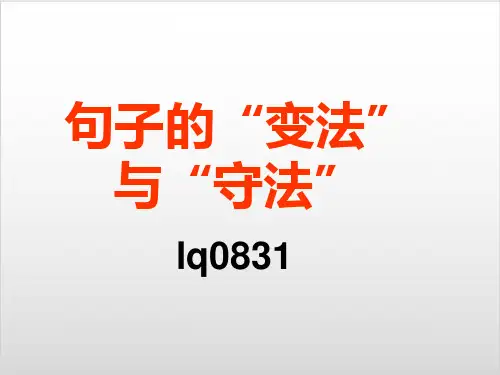
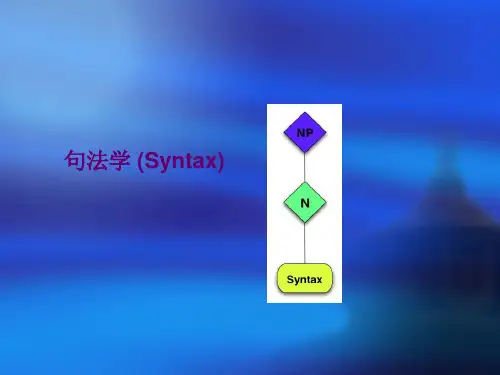
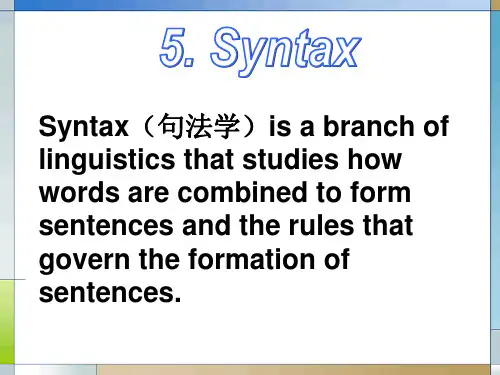

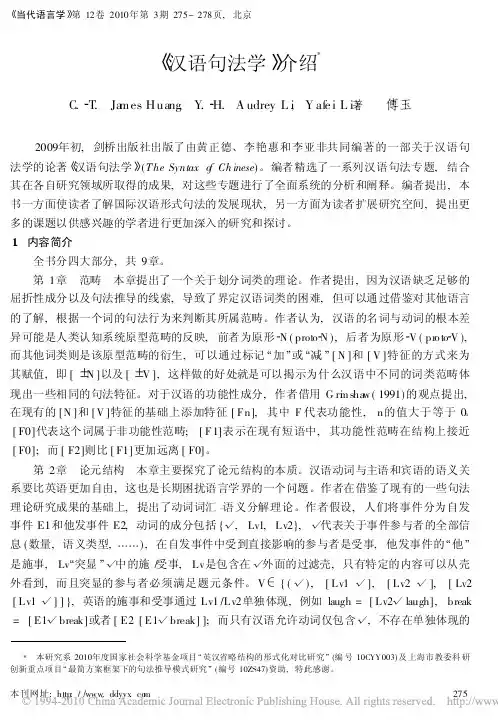
当代语言学 第12卷2010年第3期275-278页,北京汉语句法学 介绍*C. T .Ja mes Huang ,Y . H.A udrey L ,i Y afe i L i 著傅玉2009年初,剑桥出版社出版了由黄正德、李艳惠和李亚非共同编著的一部关于汉语句法学的论著 汉语句法学 (The Syntax o f Ch inese )。
编者精选了一系列汉语句法专题,结合其在各自研究领域所取得的成果,对这些专题进行了全面系统的分析和阐释。
编者提出,本书一方面使读者了解国际汉语形式句法的发展现状,另一方面为读者扩展研究空间,提出更多的课题以供感兴趣的学者进行更加深入的研究和探讨。
1.内容简介全书分四大部分,共9章。
第1章范畴本章提出了一个关于划分词类的理论。
作者提出,因为汉语缺乏足够的屈折性成分以及句法推导的线索,导致了界定汉语词类的困难,但可以通过借鉴对其他语言的了解,根据一个词的句法行为来判断其所属范畴。
作者认为,汉语的名词与动词的根本差异可能是人类认知系统原型范畴的反映,前者为原形 N (proto N ),后者为原形 V (pr o to V ),而其他词类则是该原型范畴的衍生,可以通过标记 加!或 减![N ]和[V ]特征的方式来为其赋值,即[∀N ]以及[∀V ],这样做的好处就是可以揭示为什么汉语中不同的词类范畴体现出一些相同的句法特征。
对于汉语的功能性成分,作者借用G ri m sha w (1991)的观点提出,在现有的[N ]和[V ]特征的基础上添加特征[Fn],其中F 代表功能性,n 的值大于等于0。
[F0]代表这个词属于非功能性范畴;[F1]表示在现有短语中,其功能性范畴在结构上接近[F0];而[F2]则比[F1]更加远离[F0]。
第2章论元结构本章主要探究了论元结构的本质。
汉语动词与主语和宾语的语义关系要比英语更加自由,这也是长期困扰语言学界的一个问题。
作者在借鉴了现有的一些句法理论研究成果的基础上,提出了动词词汇#语义分解理论。

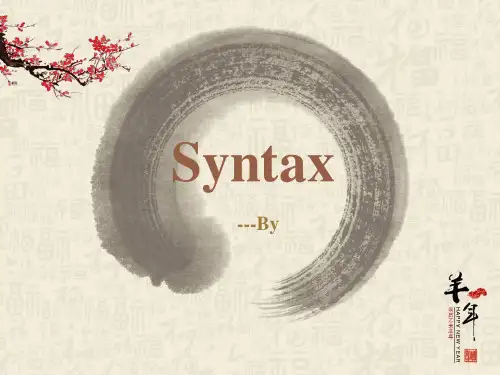
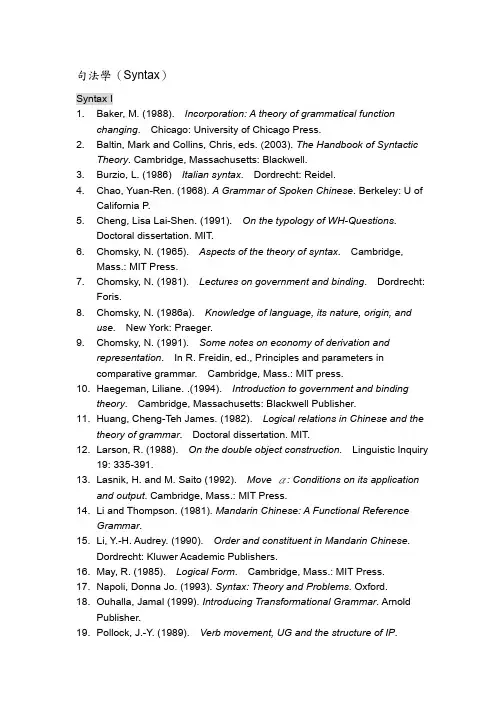
句法學(Syntax)Syntax I1. Baker, M. (1988). Incorporation: A theory of grammatical functionchanging. Chicago: University of Chicago Press.2. Baltin, Mark and Collins, Chris, eds. (2003). The Handbook of SyntacticTheory. Cambridge, Massachusetts: Blackwell.3. Burzio, L. (1986) Italian syntax. Dordrecht: Reidel.4. Chao, Yuan-Ren. (1968). A Grammar of Spoken Chinese. Berkeley: U ofCalifornia P.5. Cheng, Lisa Lai-Shen. (1991). On the typology of WH-Questions.Doctoral dissertation. MIT.6. Chomsky, N. (1965). Aspects of the theory of syntax. Cambridge,Mass.: MIT Press.7. Chomsky, N. (1981). Lectures on government and binding. Dordrecht:Foris.8. Chomsky, N. (1986a). Knowledge of language, its nature, origin, anduse. New York: Praeger.9. Chomsky, N. (1991). Some notes on economy of derivation andrepresentation. In R. Freidin, ed., Principles and parameters incomparative grammar. Cambridge, Mass.: MIT press.10. Haegeman, Liliane. .(1994). Introduction to government and bindingtheory. Cambridge, Massachusetts: Blackwell Publisher.11. Huang, Cheng-Teh James. (1982). Logical relations in Chinese and thetheory of grammar. Doctoral dissertation. MIT.12. Larson, R. (1988). On the double object construction. Linguistic Inquiry19: 335-391.13. Lasnik, H. and M. Saito (1992). Move α: Conditions on its applicationand output. Cambridge, Mass.: MIT Press.14. Li and Thompson. (1981). Mandarin Chinese: A Functional ReferenceGrammar.15. Li, Y.-H. Audrey. (1990). Order and constituent in Mandarin Chinese.Dordrecht: Kluwer Academic Publishers.16. May, R. (1985). Logical Form. Cambridge, Mass.: MIT Press.17. Napoli, Donna Jo. (1993). Syntax: Theory and Problems. Oxford.18. Ouhalla, Jamal (1999). Introducing Transformational Grammar. ArnoldPublisher.19. Pollock, J.-Y. (1989). Verb movement, UG and the structure of IP.Linguistic Inquiry 20: 365-424.20. Radford, Andrew. (1988). Transformational grammar: A first course.New York: Cambridge University.21. Radford, Andrew (1997). Syntactic theory and the structure of English.New York: Cambridge University.22. Rizzi, L. (1990). Relativized minimality. Cambridge, Mass.: MIT Press.Syntax IIBooks1. Chomsky, N. (1995). The minimalist program. Cambridge, Mass.: MITPress.2. Lasnik, H. (1999). Minimalist Analysis. Cambridge, Massachusetts:Blackwell.3. Poole, Geoffrey. (2002). Syntactic Theory. New York: Palgrave Macmillan. Articles4. Finer, D. L. (1991). “Binding Parameters in Second Language Acquisition”.Ed. Eubank, L. Point/Counterpoint Universal Grammar in the SecondLanguage. Amsterdam: John Benjamins, 351-374.5. Haegeman, L. (1990). Non-overt subjects in diary contexts. In Mascaro, J.and Nespor, M. editiors, Grammar in progress. GLOW essays for Henkvan Riesdijk. Dordrecht: Foris.6. Huang, C. T. James. (1984). “On the distribution and reference of emptypronouns.” Linguistics Inquiry. 15:531-74.7. Huang, C. T. James. (1990). Pro-drop in Chinese: A Generalized ControlTheory, in O. Jaeggli and K. Safir (ed.) The Null Subject Parameter.185-214.8. Huang, C. T. James and Tang, C. C. Jane (1991). The local nature of thelong-distance reflexive. Chinese, Long-distance Anaphora (eds.) by J.Koster and E. Reuland. Cambridge: Cambridge UP.9. Liceras, J. M. and Diaz, Lourdes. (1990). Topic-drop versus pro-drop: nullsubjects and pronominal subjects in the Spanish L2 of Chinese, English, French, German and Japanese speakers, Second Language research15,1: 1-40.10. Tang, C. C. Jane 1989, Chinese reflexives, Natural Language andLinguistic Theory. 7: 93-121.11. Tsai, W.-T. Dylan 2002, <自己、自性、與自然-談漢語中的反身狀語>,[self, Selfness, and Nature: on Reflexive Adverbials in Chinese], <中國語文>第四期12. White, L. (1985). The pro-drop parameter in adult second languageacquisition. Language Learning. 35: 531-74.13. Xu, L. (1993). “The long-distance binding of ziji.” Journal of ChineseLinguistics. 21:123-14214. Xu, L. (1994). “The Antecedent of ziji.” Journal of Chinese Linguistics. 22:115-136.Reference Journals15. Chinese Studies [漢學雜誌]16. Concentric[台師大英語系學報]17. Journal of East Asian Linguistics18. Journal of Chinese Linguistics19. Language and Philosophy20. Linguistic Inquiry21. Linguistic Review22. Tsing Hua Journal of Chinese Studies[清華學報]23. [中央研究院歷史語言所集刊]24. <中國語文>(大陸出版)。
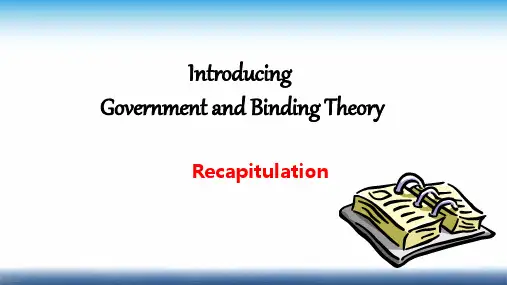
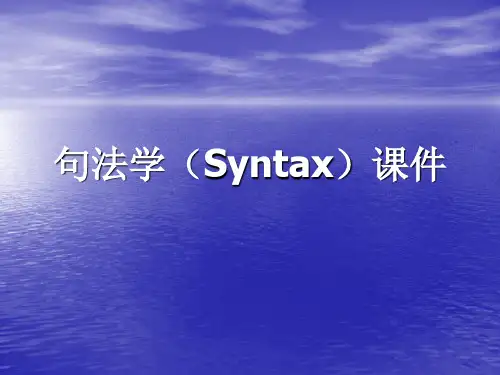
句法学名词解释解释说明以及概述1. 引言1.1 概述句法学是语言学的一个重要分支领域,它主要研究语言中的句子结构和成分之间的关系。
句法学名词解释作为句法学中的一个重要内容,在揭示语言结构和语法规则方面扮演着关键角色。
本文旨在对句法学名词解释进行全面而深入的探讨。
1.2 文章结构本文共包括五个部分,每个部分都涵盖了特定主题的讨论。
除了引入和结论外,每一部分都具有进一步细分的子标题,以便更好地组织和展示相关概念。
1.3 目的文章旨在通过解释说明、方法论、实例阐述等方式,深入剖析句法学名词解释及其在语言学研究中的应用价值。
由于句法学名词解释作为基础性概念和术语的集合,它不仅能够帮助我们理解句子结构和语法规则,还能够推动更广泛的句法分析、语料库应用和功能研究等领域发展。
以上是“1. 引言”部分内容,请继续撰写下面的内容。
2. 句法学名词解释2.1 句法学基本概念句法学是语言学的一个分支,主要研究语言中的句子结构和句子成分之间的关系。
在句法学中,名词是非常重要的一种词类,它在句子中通常充当主语、宾语或其他补充成分等不同的角色。
了解和掌握名词的特性对于理解句子结构和推断其意义至关重要。
2.2 名词解释的重要性名词是一种基本的语法范畴,在句子中起着多种功能。
通过对名词进行深入解释,我们可以更好地理解句子结构和语言表达。
名词对于确定句子的逻辑意义、描述事物特征以及构建复杂表达都起到了至关重要的作用。
因此,准确理解名词并正确运用在语言学研究中具有巨大价值。
2.3 句法学名词解释方法论在进行句法学名词解释时,有一些常见的方法可以帮助我们确立概念并更好地理解其含义。
首先,我们可以从定义出发,详细说明该名词所代表的对象或概念。
其次,对于复杂的名词,我们可以通过分类和例证的方式来加深理解。
此外,比较研究也是一种有效的方法,通过将该名词与其他相似或相反的概念进行对比分析,可以更清晰地理解其特点和含义。
通过以上方法论,我们能够以系统化和全面的方式解释句法学中涉及到的各种名词概念和术语。